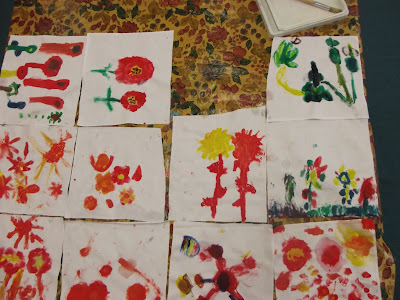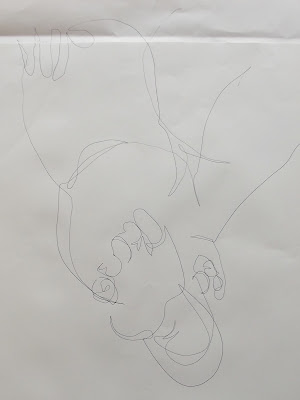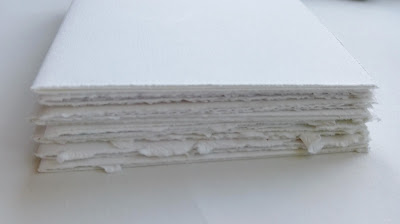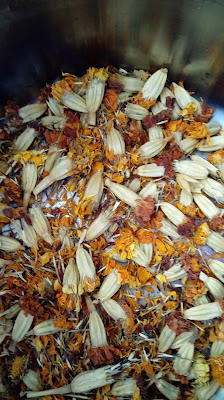 |
| Painting Flowers |
This is another of my 'catching up' posts! Last year I spent a lovely day at Wiggonby School doing felt-making with Key Stage 1. They must have enjoyed it too as I was very pleased to be asked back again, this time to work with the whole school. They chose to do some fabric painting and as it was close to Mothers Day they wanted something the children could take home. I decided that teaching them some different techniques that they could combine to make flower pictures would be a good option.
I chose to share two different methods of fabric painting, one to create a background and one to create flowers, that could be combined effectively to make a piece of floral textile art for the children to take home. As often happens, the best laid plans don't always work out so although I had time to do both types of fabric painting with both KS2 (in the morning) and KS1 (in the afternoon) we didn't have time to put the pieces together. I tend to avoid painting in most of my workshops for the simple reason of drying time. Although we had a great time and I think most the students enjoyed it and learnt something it is frustrating not being able to finish something because it's not dry (that and finding space to dry 60+ pieces of fabric!)
The first technique I showed the students was using watered down paint on wet fabric to create abstract, watercolour like backgrounds. We talked a bit about colour theory and I encouraged them to choose one primary colour and one of the complementary colours including that primary (e.g. blue and green or blue and purple) and to see how many variations they could get using just those two colours. Choosing colours this way also helps prevent all the colours being mixed together into a brown sludgy mess! We added a bit of detail to our watery backgrounds by flicking thicker paint on top, always a fun method of painting and good to help loosen up those students who can get a bit stuck with fear of getting it wrong.
The second technique I showed the students was using the fabric paint more thickly and blending the colours on the fabric (again choosing two colours that would not create brown) to create flowers. We did this on a separate piece of fabric so that when the paint was dry the flowers could be cut out and stuck onto the watercolour backgrounds to create a unique piece of art. This was the bit that I didn't get to do with the children as the fabric wasn't dry in time!
One of the things I find really interesting as I'm working with different groups and in different places is people's different perceptions of what is 'good' art and in schools in particular this often means neat and realistic. One of the things I try and encourage in all my students is a willingness to try things and take risks. Creativity is not always about getting it right, it's about trying things and finding solutions to challenges.
I often find that the students who I'm told are 'really good at art' are not the most creative, they are often technically skilled but are also often quite set in their ways and unwilling to try new things as they've found a way that works and is perceived as good so why would they do something different. This was particularly noticeable amongst the older students, when we moved onto the second technique and I asked them to sketch out some flower shapes I was met with the familiar line of 'but I can't draw.'
There are lots of arguments about drawing and the 'I can't draw' scenario and the blame is often laid at teachers doors for not being supportive or encouraging enough, however, I've never found evidence of this in a primary school. I'm inclined to agree with Joanna O'Neil (whose drawing workshop 'Sonnets and Shopping Lists' I attended at Cumberland Embroiderers Guild last year) who believes it's down to personal perception; at a certain point children realise that their drawing does not match the object they are drawing. Their perception and understanding exceeds their technical ability, for some people this is an almost insurmountable block to carrying on with drawing.
Overall it was a very enjoyable day, we had a lot of fun painting and some of the students who thought they weren't so creative found out they were and we produced some beautiful effects.


























































